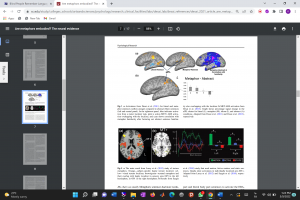Brain Functional Connectivity (fNIRS) in the Resting State and the Exercise State in Elite Tai Chi Chuan Athletes
Tai chi chuan is a form of physical and mental exercise that originated in ancient China. It is a combination of a series of rigid and soft, dynamic and static, virtual, physical, and other complex body movements. Excellent tai chi athletes have continuously pursued and emphasized the integrity and standardization of their movements during their long years of training. While their movements are highly artistic, they also have extremely high requirements for physical and mental coordination.
A new study, led by Wang et al. (2022), published in frontiers in human neuroscience, recruited 13 elite tai chi chuan athletes (with 10–15 years of tai chi chuan training) as the expert group at Beijing Sport University, and 11 students inexperienced in tai chi chuan (with 0.5–1 years of tai chi chuan training) as the novice group, aged between 20–25 years. Resting state and exercise state were monitored for a total of 5 min through Nirsmart portable brain function imaging device collected by near-infrared light with two wavelengths of 760 nm and 850 nm (sampling frequency is 10 Hz).
- There were significant differences between LPFC-RSMC (p < 0.05). This difference may reflect experience-dependent neuroplasticity, which refers to the ability to change brain structure or function under the action of the external environment or experience. Therefore, we believe that the changes in brain function of the expert group may be related to long-term participation in specific motor skill training.
- The expert group demonstrated lower FC strength in the frontal and parietal regions compared with the control group. we speculated that the declining tendency of professional tai chi chuan athletes in the FC of the frontal and parietal lobes may be related to the reduced energy consumption required for cognitive control and the lower attention control load in the resting state.
- the dynamic FC between expert and novice groups was significantly different (p < 0.05), which mainly manifested as weakened FC strength in the expert group in LPFC-RSMC, RPFC-LSMC, and LSMC-RSMC. Behavioral results revealed that the expert group had higher scores in attention concentration and kinesthetic perception.
- The decrease in FC between brain regions shown by the expert group may be related to the improvement of neural efficiency after long-term intensive training. The “efficiency” hypothesis suggests that with the improvement of skill level, task execution becomes more automated as specific brain regions are devoted to specific neural activities.
Results showed long-term tai chi training can reduce the synergic effect of the lower frontoparietal brain region, suggesting that professional athletes have lower attention control load in the resting state, which provides new neuroimaging evidence for the plasticity of brain function in tai chi exercise. During exercise, the intensities of intercerebral FC of professional athletes were significantly reduced and the performance of motor skills was elite, supporting the neural efficiency hypothesis.
The improvement of the neural performance of professional athletes while performing tai chi chuan exercises may be related to the brain’s high adaptability to special tasks and the gradual improvement of body perception processing and motor function integration.




Related Posts